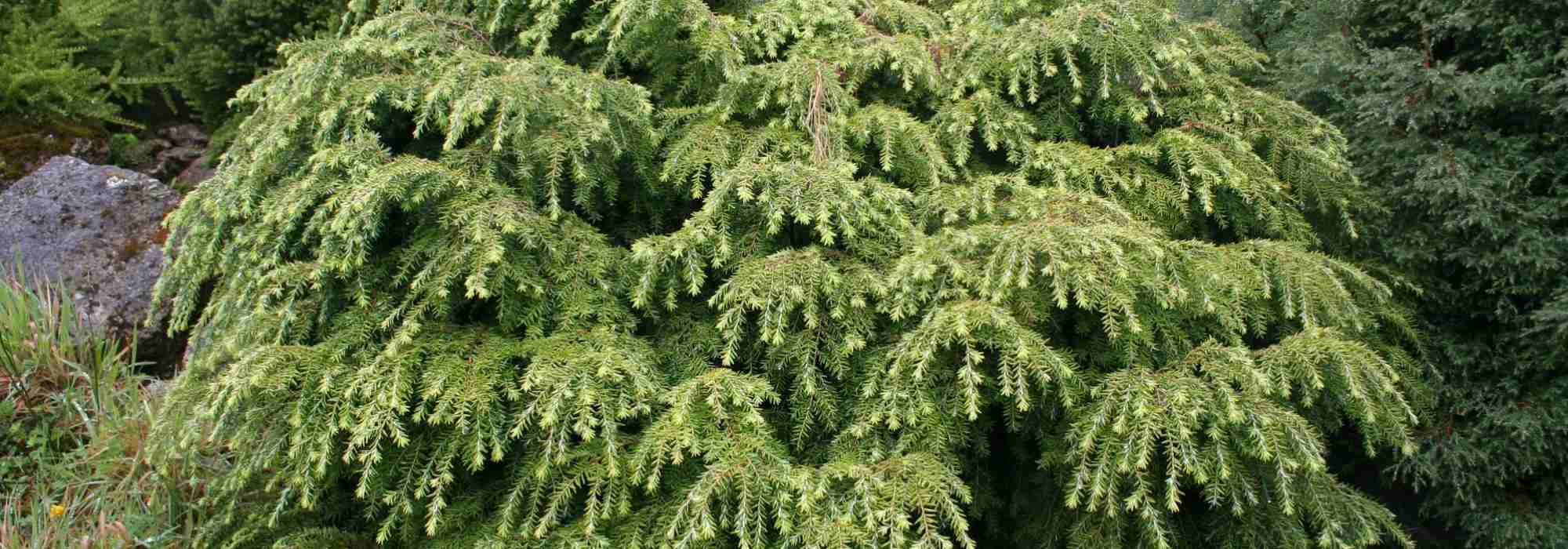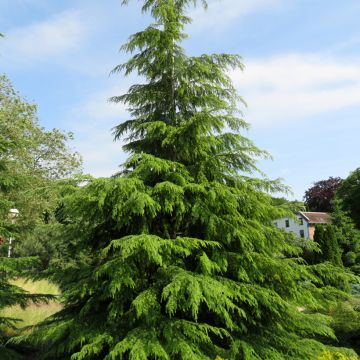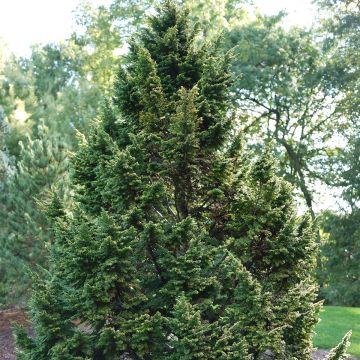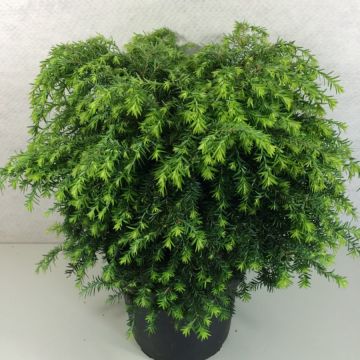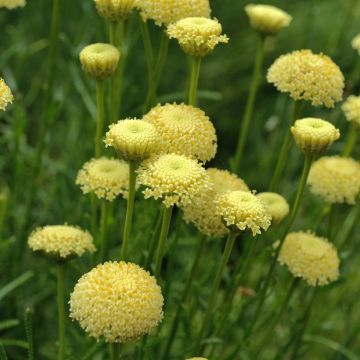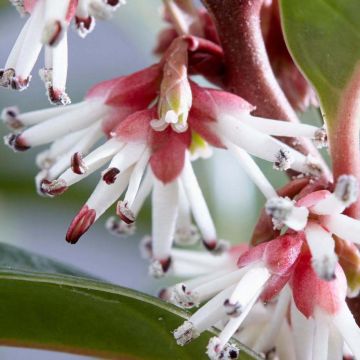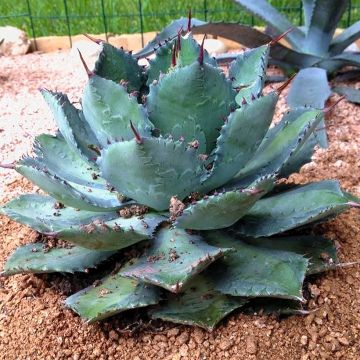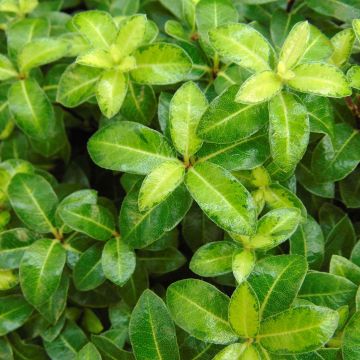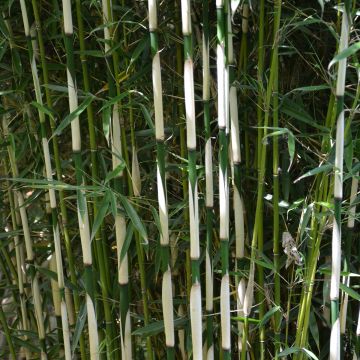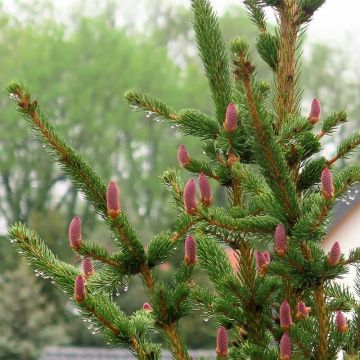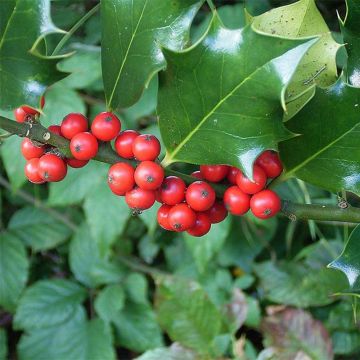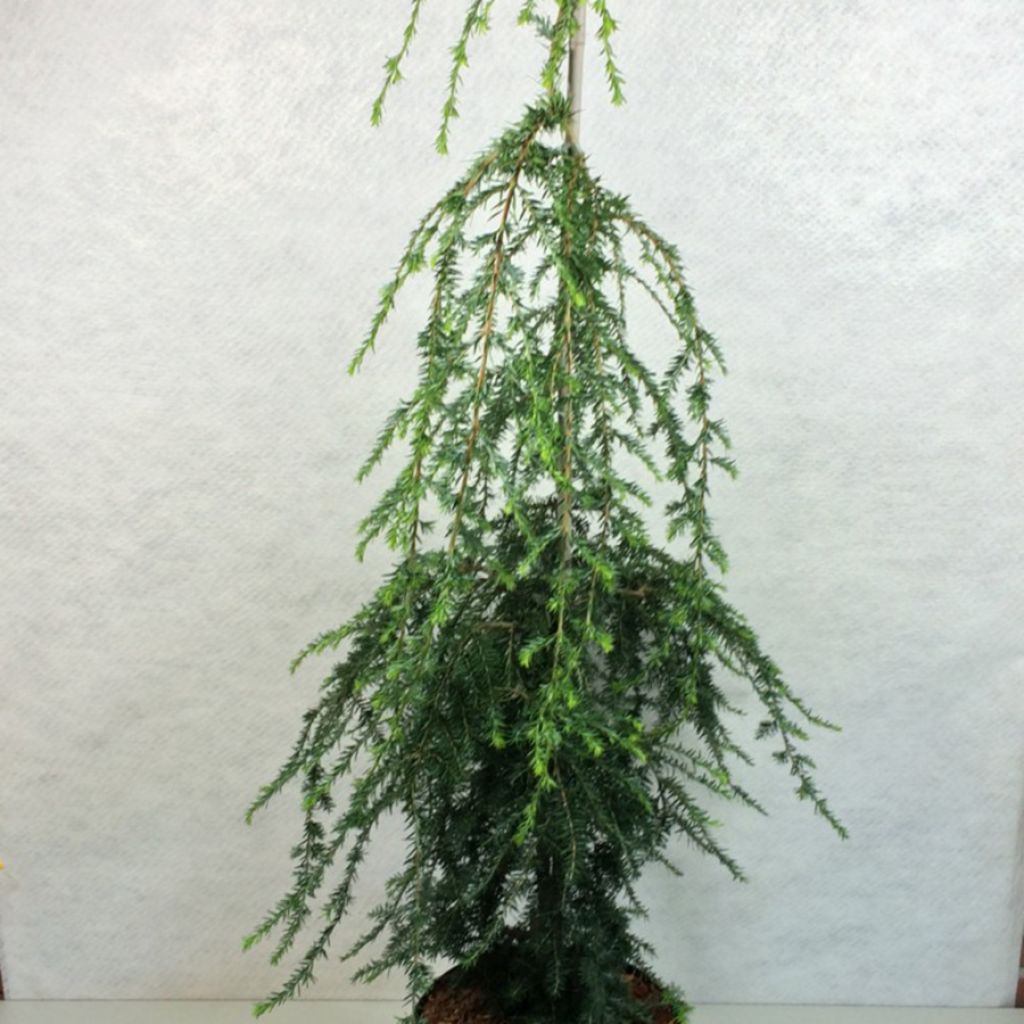

Tsuga canadensis Pendula - Pruche du Canada
Tsuga canadensis Pendula - Eastern Hemlock
Tsuga canadensis Pendula
Eastern Hemlock, Canadian Hemlock, Eastern hemlock-spruce
Received a well-developed young plant but it has suffered a bit in its pot: it was cramped and poorly repotted, with a whole empty space at the level of the roots. As a result, some branches have slightly pale needles.
Aurélie, 10/04/2019
Special offer!
Receive a €20 voucher for any order over €90 (excluding delivery costs, credit notes, and plastic-free options)!
1- Add your favorite plants to your cart.
2- Once you have reached €90, confirm your order (you can even choose the delivery date!).
3- As soon as your order is shipped, you will receive an email containing your voucher code, valid for 3 months (90 days).
Your voucher is unique and can only be used once, for any order with a minimum value of €20, excluding delivery costs.
Can be combined with other current offers, non-divisible and non-refundable.
Home or relay delivery (depending on size and destination)
Schedule delivery date,
and select date in basket
This plant carries a 24 months recovery warranty
More information
We guarantee the quality of our plants for a full growing cycle, and will replace at our expense any plant that fails to recover under normal climatic and planting conditions.
Would this plant suit my garden?
Set up your Plantfit profile →
Description
Tsuga canadensis 'Pendula' is a small-sized conifer that grows slowly. Over time, it takes the shape of a lush, spread-out, and low dome with a naturally weeping and creeping habit. Its twisted and trailing branches grow in multiple directions; a slightly more upright habit can be achieved by guiding the main scaffold branch and pruning the lower ones. Its green and shiny needles are arranged along consistently weeping branches, resembling draperies, giving this shrub exceptional ornamental value. Small pendant, ovoid, and brown cones may appear on well-established plants. It requires a moist, neutral to acidic soil, and prefers a relatively cool exposure, sheltered from the wind.
Tsuga canadensis, also known as Eastern Hemlock, is an evergreen conifer of the pine family, native to Eastern Canada, where it often grows in mixed forests and maple groves, always in shade. This species slowly reaches a height of 30 m (98ft), with a diameter of 1 m (3ft), and can live up to 600 years. This very hardy conifer prefers fertile and moist soils, and does not tolerate drought or direct sunlight. Its roots are shallow and spreading widely.
The 'Pendula' variety, derived from this species, caused a sensation when it was discovered in Germany before 1891. It is distinguished by its moderate size, and its fantastic habit, in the shape of a large weeping dome, spread-out and low, or sometimes truly creeping if allowed to grow naturally. Its growth is slow. If left to grow without intervention, it will not exceed a height of 1m (3ft) at maturity, with a spread of 5 to 6 m (16 to 20ft). If, on the other hand, its growth is guided upwards, it can reach 3 to 4 m (10 to 13ft) in height and 5 m (16ft) in diameter. Its gnarled and unpredictable branches, emerging from a very short trunk, gracefully droop and spread on the ground. They are covered with a smooth, orange-brown bark, which becomes dark brown and grooved with age. The branches that inevitably point towards the ground are covered with flat and short needles, 7 to 16 mm (1in) long, finely toothed, vibrant green on the upper side with two white bands on the underside. They are arranged in two ranks on the twigs. The bark starts peeling off from a young age. The small, brown, and tiny cones that sometimes appear on adult plants measure 1 to 2 cm (1in) in length.
Tsuga canadensis 'Pendula' forms a monumental specimen that does not go unnoticed in a garden. Left to its own devices, it can be used as ground cover in a large rock garden, or to cover a wall, gracefully cascading over it. If trained as a shrub , it can create a sumptuous backdrop for a flower bed or be used in a woodland edge, as it appreciates the shelter provided by trees and large shrubs. It pairs well with large stones and well-maintained lawns; it can be planted in moist soil. It can also contribute to the design of a natural pond or water feature, near the freshness it seeks, in a non-exposed position. The true graphic qualities of conifers and the infinite choices available to gardeners, in all climates of our country, naturally impose themselves in the design of contemporary gardens, which favors the aesthetics of shapes, silhouettes, and textures over the dance of blooms. These plants, with their reassuring permanence, structurally define a flower bed, mark pathways, line terraces, easily replacing the strong presence of trimmed boxwood or holly. The key is to play with volumes and colours.
Tsuga canadensis Pendula - Eastern Hemlock in pictures
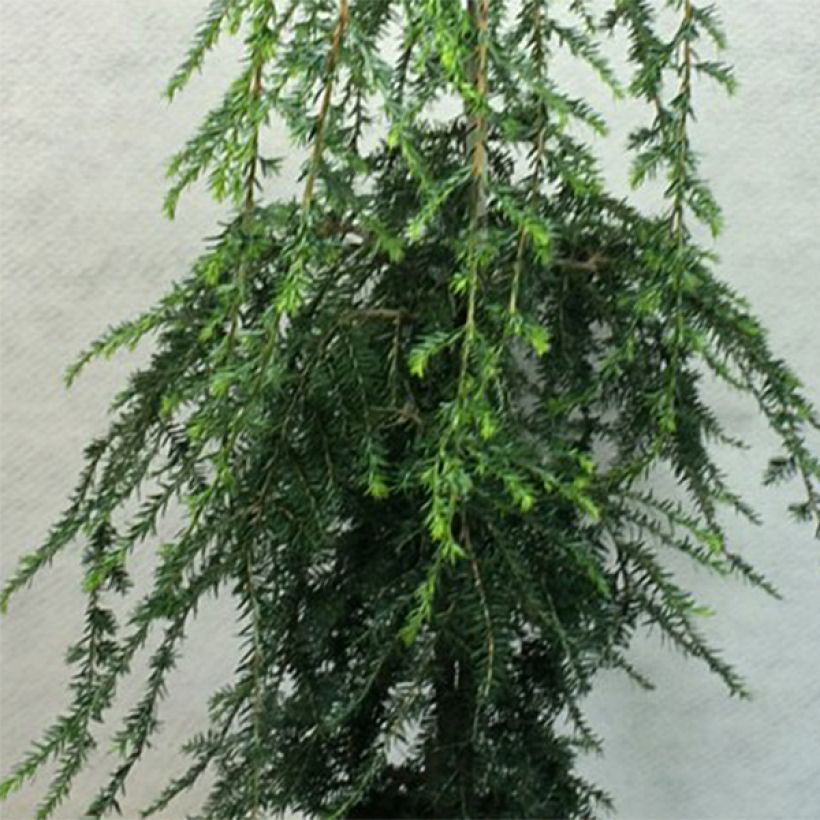

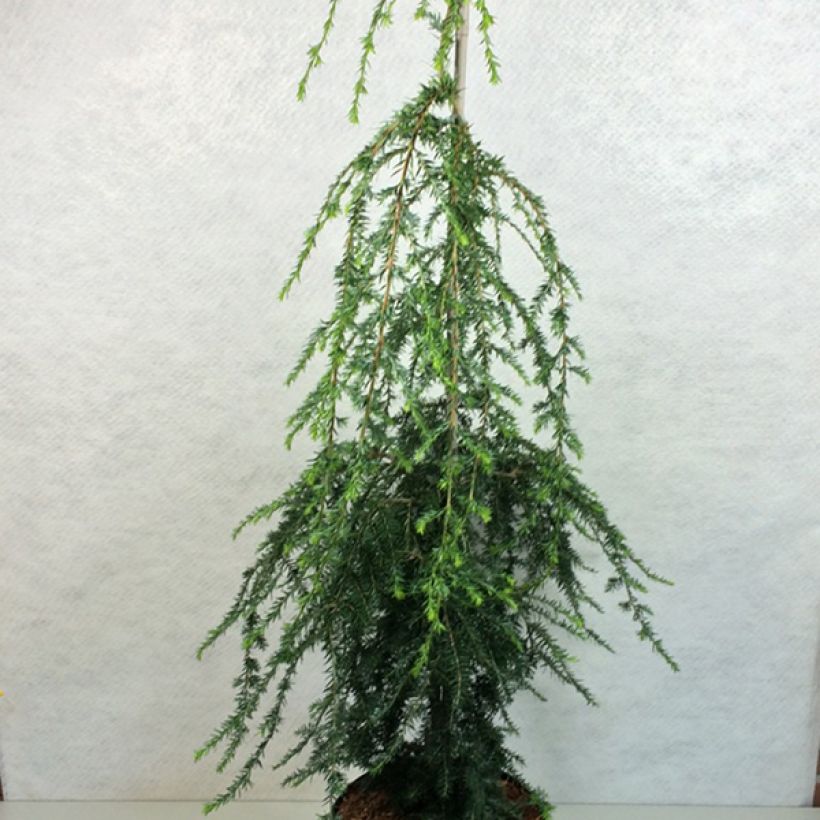

Plant habit
Flowering
Foliage
Botanical data
Tsuga
canadensis
Pendula
Pinaceae
Eastern Hemlock, Canadian Hemlock, Eastern hemlock-spruce
Cultivar or hybrid
Other Tsuga
View all →Planting and care
Tsuga canadensis 'Pendula' can be planted from September to November or from February to June in ordinary but fertile soil that retains moisture. The soil should be well-drained and neutral to slightly acidic. It prefers humus-rich and moist soils that are not too chalky. Choose a spot that receives morning sun, partially shaded or densely shade in warmer climates, and protected from strong winds that could uproot it. Soak the root ball thoroughly before planting. Add organic amendment during planting and water generously for the first three years, and especially during prolonged droughts. Apply a special conifer fertiliser annually in April and hoe the soil in summer. This very hardy conifer (down to at least -30 °C (1°F)) dislikes direct sunlight and dry, poor soils. Its naturally trailing habit can be controlled through pruning and guided by staking the main branch.
Planting period
Intended location
Care
Planting & care advice
-
, onOrder confirmed
Reply from on Promesse de fleurs
Similar products
Haven't found what you were looking for?
Hardiness is the lowest winter temperature a plant can endure without suffering serious damage or even dying. However, hardiness is affected by location (a sheltered area, such as a patio), protection (winter cover) and soil type (hardiness is improved by well-drained soil).

Photo Sharing Terms & Conditions
In order to encourage gardeners to interact and share their experiences, Promesse de fleurs offers various media enabling content to be uploaded onto its Site - in particular via the ‘Photo sharing’ module.
The User agrees to refrain from:
- Posting any content that is illegal, prejudicial, insulting, racist, inciteful to hatred, revisionist, contrary to public decency, that infringes on privacy or on the privacy rights of third parties, in particular the publicity rights of persons and goods, intellectual property rights, or the right to privacy.
- Submitting content on behalf of a third party;
- Impersonate the identity of a third party and/or publish any personal information about a third party;
In general, the User undertakes to refrain from any unethical behaviour.
All Content (in particular text, comments, files, images, photos, videos, creative works, etc.), which may be subject to property or intellectual property rights, image or other private rights, shall remain the property of the User, subject to the limited rights granted by the terms of the licence granted by Promesse de fleurs as stated below. Users are at liberty to publish or not to publish such Content on the Site, notably via the ‘Photo Sharing’ facility, and accept that this Content shall be made public and freely accessible, notably on the Internet.
Users further acknowledge, undertake to have ,and guarantee that they hold all necessary rights and permissions to publish such material on the Site, in particular with regard to the legislation in force pertaining to any privacy, property, intellectual property, image, or contractual rights, or rights of any other nature. By publishing such Content on the Site, Users acknowledge accepting full liability as publishers of the Content within the meaning of the law, and grant Promesse de fleurs, free of charge, an inclusive, worldwide licence for the said Content for the entire duration of its publication, including all reproduction, representation, up/downloading, displaying, performing, transmission, and storage rights.
Users also grant permission for their name to be linked to the Content and accept that this link may not always be made available.
By engaging in posting material, Users consent to their Content becoming automatically accessible on the Internet, in particular on other sites and/or blogs and/or web pages of the Promesse de fleurs site, including in particular social pages and the Promesse de fleurs catalogue.
Users may secure the removal of entrusted content free of charge by issuing a simple request via our contact form.
The flowering period indicated on our website applies to countries and regions located in USDA zone 8 (France, the United Kingdom, Ireland, the Netherlands, etc.)
It will vary according to where you live:
- In zones 9 to 10 (Italy, Spain, Greece, etc.), flowering will occur about 2 to 4 weeks earlier.
- In zones 6 to 7 (Germany, Poland, Slovenia, and lower mountainous regions), flowering will be delayed by 2 to 3 weeks.
- In zone 5 (Central Europe, Scandinavia), blooming will be delayed by 3 to 5 weeks.
In temperate climates, pruning of spring-flowering shrubs (forsythia, spireas, etc.) should be done just after flowering.
Pruning of summer-flowering shrubs (Indian Lilac, Perovskia, etc.) can be done in winter or spring.
In cold regions as well as with frost-sensitive plants, avoid pruning too early when severe frosts may still occur.
The planting period indicated on our website applies to countries and regions located in USDA zone 8 (France, United Kingdom, Ireland, Netherlands).
It will vary according to where you live:
- In Mediterranean zones (Marseille, Madrid, Milan, etc.), autumn and winter are the best planting periods.
- In continental zones (Strasbourg, Munich, Vienna, etc.), delay planting by 2 to 3 weeks in spring and bring it forward by 2 to 4 weeks in autumn.
- In mountainous regions (the Alps, Pyrenees, Carpathians, etc.), it is best to plant in late spring (May-June) or late summer (August-September).
The harvesting period indicated on our website applies to countries and regions in USDA zone 8 (France, England, Ireland, the Netherlands).
In colder areas (Scandinavia, Poland, Austria...) fruit and vegetable harvests are likely to be delayed by 3-4 weeks.
In warmer areas (Italy, Spain, Greece, etc.), harvesting will probably take place earlier, depending on weather conditions.
The sowing periods indicated on our website apply to countries and regions within USDA Zone 8 (France, UK, Ireland, Netherlands).
In colder areas (Scandinavia, Poland, Austria...), delay any outdoor sowing by 3-4 weeks, or sow under glass.
In warmer climes (Italy, Spain, Greece, etc.), bring outdoor sowing forward by a few weeks.






























